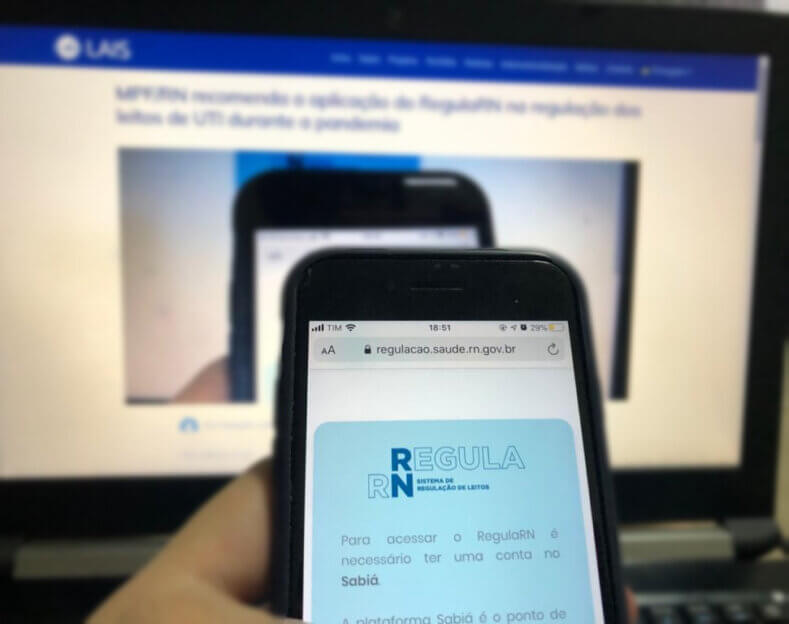By Dênia Cruz
The Federal Public Ministry (MPF / RN) and the Rio Grande do Norte Public Ministry recommended the State Government to keep the RegulaRN platform updated, which regulates the beds of the Intensive Care Unit (ICU) in RN. The action aims to ensure greater control of the situation due to the pandemic of the new coronavirus. The system is a realization of the Laboratory of Technological Innovation in Health of the Federal University of Rio Grande do Norte (LAIS / UFRN).
According to the MPF / RN, the action is of paramount importance for the implementation of the system and the proper regularization and monitoring of the number of beds throughout the state. The recommendation was made by attorney Fernando Rocha de Andrade.
According to the Public Prosecutor, the platform developed by LAIS meets the requirements required by health legislation, while providing a fundamental tool for public managers to access, in real time, information about the situation of beds targeted at patients. infected by COVID-19 in RN. The MPF / RN representative pointed out that the system “is a dynamic and intuitive instrument, which brings transparency to the regulation of beds in the state”.
He also stated that the RegulaRN is also an invitation for the whole society to get to know the situation of the health system in the state with the necessary depth, guaranteeing equality and efficiency in its regulation. “It is essential that health professionals know the tool, use it as a work routine and feed it with the precision and speed necessary for its full efficiency”, he stressed.
In view of the new coronavirus pandemic, the lack of beds for the care of infected people, especially at a more severe stage of COVID-19, is one of the main difficulties faced by the health departments. To solve this problem in the hospital management of the state, RegulaRN was created, which is an integrated system developed to manage the occupation and availability of beds in the health network (state and municipalities), with the objective of ordering and standardizing the flow of access to ICU beds for patients in need of treatment against COVID-19.
RegulaRN is a platform fully developed by the team of researchers in Information Technology (IT) at LAIS, who voluntarily created the system as a collaborative measure in the fight against the new coronavirus, meeting a demand suppressed by SESAP for years, which needed a bed regulation system for the state health network.
According to Pablo Holanda, technical coordinator of the development team at RegulaRN, all work was carried out in partnership with the team of regulators from the Health Department (doctors and nurses), who defined the requirements for the system. “SESAP / RN had a spreadsheet used to make the regulation, what we did was to create a system that optimizes the response time for the use of the beds, having access to a situation room that shows all available offers in the units and how it is being used. Currently, RegulaRN is being implemented with COVID-19 to validate the system as a whole, as it is a contingency moment due to the pandemic. But the system is prepared for any regulatory flow. After this stage, we will transfer all technology to the Health Department, and we can continue to provide technical support to the state ”, he explained.
According to professor Ricardo Valentim, LAIS coordinator, the system collaborates to promote transparency, integrity and control in access to health services in the state, improving and perfecting the regulation of beds in RN. “The RegulaRN platform is a health information system developed based on the national bed regulation legislation and in accordance with the regulations in force in the state of RN. This system was created at this time because of the pandemic of COVID-19 to support the state, in terms of logistics and operations, as the system optimally organizes and distributes the beds, signaling to the manager where these beds are and how they can patients needing ICU be referred ”, he said.
Valentim also explained that Regula RN allows a georeferenced view of the beds. “This helps in the application of actions so that there is no lack of beds, equipment, or PPE, according to the regulation rules, and thus guaranteeing maximum assistance to patients.”
For the team coordinator of RegulaRN, professor Lyane Ramalho, the system brings important information for hospital assistance with regard to receiving patients, such as the search, listing, situation and how to perform actions in the registered beds. “With RegulaRN, it is possible to predict whether the health network is close to overcrowding, if there are beds available and where they are, if they are blocked and for what reason, if they have a reservation, if they have the capacity to serve and for how long. The system provides us with a map of information about the situation of ICU vacancies in the state. This brings transparency to society and to health management, effectively helping to tackle COVID-19”.
Technological Ecosystem
Regula RN is part of the Technological Ecosystem created by the Laboratory of Technological Innovation in Health – LAIS / UFRN. In total, there are 10 applications and / or systems that include the training of health professionals and managers, as well as the population in general; monitoring the figures for the COVID-19 pandemic; Telehealth and monitoring of health services.





